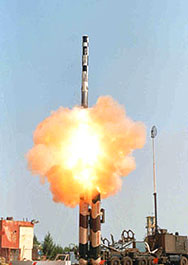BrahMos Aerospace goes deepwater fishing — looks for a submarine
01 Feb 2007
 "We are ready with the designs and looking for a platform to launch the missile from under the sea," BrahMos Aerospace CEO A Sivathanu Pillai said. The Indo-Russian joint venture, between India's defence research and development organisation (DRDO) and Russia's NPO Mashinostroyenia, has asked the Indian Navy to loan one of its Russian-made Kilo-class submarines as a test platform for the new missile, as the DRDO lacks an adequate platform to carry out the task.
"We are ready with the designs and looking for a platform to launch the missile from under the sea," BrahMos Aerospace CEO A Sivathanu Pillai said. The Indo-Russian joint venture, between India's defence research and development organisation (DRDO) and Russia's NPO Mashinostroyenia, has asked the Indian Navy to loan one of its Russian-made Kilo-class submarines as a test platform for the new missile, as the DRDO lacks an adequate platform to carry out the task.
Alternatively, as in the case of its indigenously developed jet engine, Kaveri, India may once again conduct the tests piggybacking on a Russian platform. In the case of Kaveri, its high-altitude tests were carried out on the high speed Russian jet bomber, the Tu-16 (Nato reporting name-Badger).
According to reports, the missile is also being configured for Russia's 1850 tonne, Amur-class submarines, which, it is speculated, may compete for a second-line of submarine construction at the Mazgaon Docks, in tandem with the French Scorpene line.
Media reports, quoting Pillai, suggest that the submarine launched version will require the installation of a 7.65 metre thick cylindrical module in the submarine structure, which will house the missiles as well as the fire control system.
Induction plans
The ship-launched versions have already been inducted by the Indian Navy on its Russian supplied Kashin class destroyers, with the INS Rajput being the first one to deploy the 290 km range missile. The ship-launched version had successfully knocked out a decommissioned Indian Navy Petya class missile boat in a test conducted in April 2005.
 The Navy's three new Talwar-class frigates, on order from Russia, as well as the three Delhi-class destroyers and its Godavari-class frigates are expected to induct the BrahMos system next.
The Navy's three new Talwar-class frigates, on order from Russia, as well as the three Delhi-class destroyers and its Godavari-class frigates are expected to induct the BrahMos system next.
The Indian Army has already cleared induction of the surface-to-surface version after a successful demonstration at the Pokharan test-firing range. The induction should take place by the end of the year.
The air-launched version is likely to begin preliminary tests this year, and will culminate in flight tests on an IAF Su-30MKI fighter next year. According to Pillai, at least twelve tests of the BrahMos missile have been carried out in extreme conditions, all of which have been successful.
BrahMos Aerospace is quite upbeat about the sales prospects of the missile in the global markets. It expects to sell at least a thousand of these missiles to Indian and Russian forces as well as other "approved" countries. Overall it expects to sell at least 2,000 such missiles in the foreseeable future.
Meanwhile, BrahMos officials have indicated that in an effort to maintain market leadership, they will create a parallel programme to create technologies over and above the missile's current capabilities. According to reports, joint study groups are already at work to arrive at the specifics of a new programme.





.webp)

.webp)























